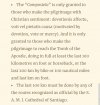As to the 1993 versus 1999 discussion (both of them Holy Years), my humble guess is that the confusion arises, again, from quotes of quotes of quotes of a misquote. I won't claim that Fernando Lalanda is infallible but unlike so many Camino authors he at least includes photos or scans of the documents he writes about. In particular:
For 1999,
@Bradypus provided a link to a screenshot and to the content of the letter that was published and/or sent, in the summer of 1999, by the Santiago Cathedral to the diocese delegates, the parishes on the
Camino de Santiago, the albergue managers and the Friends of the Camino associations to point out and/or inform them that in order to get a Compostela the pilgrim walks in principle from home to Santiago but this can be reduced to a minimum of 100 km, namely the last 100 km before Santiago. The addressees were urged to inform their parishers as well as any other actual and potential pilgrim about this requirement (a requirement that was not yet printed in the credentials at the time).
As to 1993, Lalanda writes that the format of the credential (he calls this version
credencial federativa) remained basically the same since the creation of this format from 1993 until 2016. The chapter about the 1993 credential includes photos and a description of its pages including the page where it says [translated from Spanish]:
For the granting of the Compostela by the S.I. Catedral de Santiago, the requirements established by the S.I. Catedral de Santiago must be fulfilled, bearing in mind that the Compostela is a document that is granted when the pilgrimage is made with a religious character for at least the last 100 km on foot or on horseback or 200 km by bicycle.
Now here is the rub. As this photo is pasted into the chapter about the 1993 credential, a careless reader might assume that the part of the text quoted above was already there in 1993. However, Lalanda does mention that this text passage was only included in the slightly modified 2008 edition of the 1993 credential format.




























